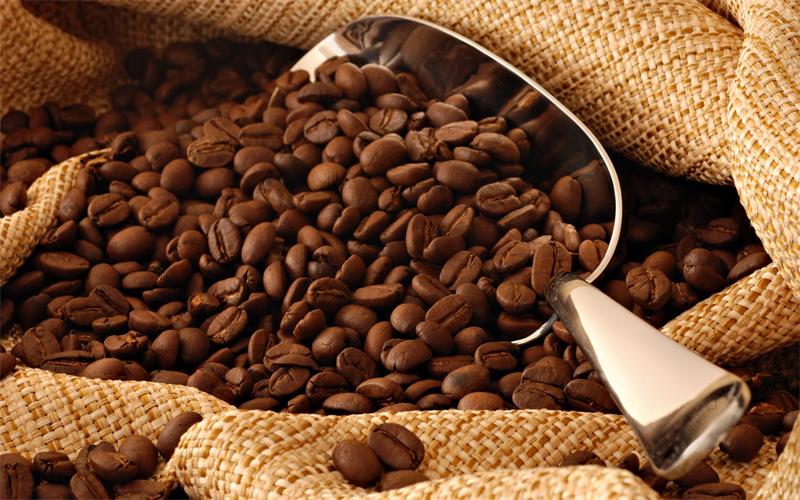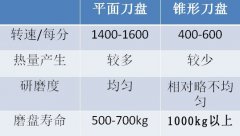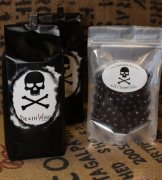Introduction to the Soul of Coffee Bean
What is the essence of a cup of coffee? Coffee as its name implies, the raw material of coffee is the most important. The main raw materials for making coffee are small and round dark brown coffee beans, which quietly emit a fragrant fragrance in the grinder and show a beautiful amber color in the cup. These are the three very deep impressions that ordinary people have on coffee. As you explore the history and beauty of coffee, you can also see the coffee trees that are caressed by the tropical sun and whose leaves twinkle. It has a small white flower similar to jasmine, its fruit from green to yellow-green, and finally to red, coffee beans are the seeds in its fruit.
If you can go to the coffee bean refinery, you can certainly see the red pulp called coffee cherry and the fresh green coffee raw beans with the endocarp and silver skin removed. These are the coffee beans for export. The fruit of coffee is dark green at birth, goes through yellow and red, and finally becomes a crimson ripe fruit. The dark red coffee fruit is very charming in appearance, and the gorgeous crimson color is their gorgeous coat. A normal fruit contains a pair of seeds, which are "coffee beans". After professional baking and cooking, and then adding all kinds of seasonings, coffee beans are popular all over the world.

There are more than 70 kinds of coffee in the world, of which 3 are mainly cultivated in China. ① small seed species, also known as Arabica coffee, is native to Ethiopia and is cultivated in Taiwan, Fujian, Guangdong, Guangxi, Yunnan and Sichuan. Shrub, 4 to 6 meters high, with many branches in the basal part; the leaves are thin leathery, ovate-lanceolate or lanceolate, entire or wavy, and the terminal buds are green or bronzed, so they are known as green-top coffee and red-top coffee. The flower is white, the fruit is many and small, the seed coat is thicker, and it is easy to separate from the kernel. There are many varieties, good quality, mellow smell, medium yield, cold tolerance, drought tolerance, but weak disease resistance. ② seed, also known as Ganfella coffee, is native to the African Congo rainforest and is distributed at low elevations between 10 °S and N, mainly in Southeast Asian countries. China is mainly cultivated in Hainan Island, and a small amount has been planted in Xishuangbanna, Yunnan Province. Small evergreen trees, 5-8 m tall, branched high, leaf blade large, thickly papery, ovate-oblong or lanceolate, margin entire or shallowly undulate. The flowers are white, sometimes reddish, and bear much fruit. The fruit is oblate or oval, purplish red when ripe, the pericarp, pulp and seed coat are thin, and the seed coat and pericarp are not easy to fall off. This species has shallow roots, weak branches, the most avoid strong winds, but strong resistance to diseases and insect pests. The product is strong and fragrant with strong irritation. ③ large-grained species, also known as Liberian coffee, is native to the lowland forests of Liberia on the west coast of Africa, widely planted in tropical low-altitude areas, and a small amount in Hainan Island, China. Evergreen trees, up to 10 m tall, branches spreading. Leaves thickly leathery, large, elliptic, Obovate-elliptic, margin entire. The flowers are white and the fruit is few. Generally, there are only 3-6 flowers in a section. The fruit is large and reddish when ripe, with a hard and thick rind and pulp. The main root is thick and long, drought-resistant, wind-resistant and cold-resistant, but it is weak in disease resistance and is most likely to be infected with leaf rust. The taste of the product is strong and hot, the irritation is big, the quality is poor.

The popular coffee on the market is mainly Arabica (Coffea Arabica) and Robsta (Coffea Robusta). The price of the former is higher, while the price of the latter is lower, so it is mostly acquired as the raw material of instant coffee. Compared with the appearance of Arabica coffee raw beans and Robusta coffee raw beans, the difference is quite obvious. Arabica is longer, flatter, more complete and greener; Robusta is more round, thicker and whiter. Both varieties of coffee trees need plenty of sunlight and water. Arabica coffee trees like the seasonal climate of 15: 24 ℃, while Robasta coffee trees like the warm equatorial climate. The temperature in this area is stable in the range of 24-29 ℃. When the temperature drops below zero, both kinds of trees will freeze to death. Volcanic soil is the favorite soil for coffee trees, which provides almost all the nutrients for coffee trees to grow. In addition to the necessary temperature, humidity and altitude are also an important indicator of coffee growth, Robasta is generally grown in lowlands about 500 meters above sea level, while Arabica is suitable for highlands between 800 and 2000 meters above sea level.
For those of you who are familiar with coffee, you should know more about coffee beans after reading this article, right? To make a good cup of coffee, you can't do without high-quality coffee beans. High-quality coffee beans come from the fertile growing environment and excellent baking technology. This is the soul in coffee.
Important Notice :
前街咖啡 FrontStreet Coffee has moved to new addredd:
FrontStreet Coffee Address: 315,Donghua East Road,GuangZhou
Tel:020 38364473
- Prev

The skill of Grinding Coffee Bean Grinding Machine effect on the Flavor of Coffee
Like drinking coffee, is a hobby, like making coffee, is a kind of mood, like making coffee, is a way of life. In China, more and more people begin to fall in love with coffee and coffee life. Baristas constantly study how to make better coffee. Constantly try different flavors of coffee beans, different tastes brought by various brewing utensils, and all kinds of brewers.
- Next

I can't sleep for several nights after a cup! Do you want to try the most refreshing coffee in history?
Coffee drinkers always have their own preferences. Some people prefer bitter taste, like to drink black coffee or Zhai coffee, in fact, can reach the level of drinking black coffee is relatively high. Some people prefer sweet taste with milk and sugar and are infatuated with lattes. There is also a small group of people constantly trying a variety of fresh coffee flavors, using a variety of heavy black coffee to vent.
Related
- Guji coffee producing area of Guji, Ethiopia: Humbela, Shakiso, Wulaga
- What is the most expensive variety of Qiloso in BOP multi-variety group?
- How to store the coffee beans bought home?
- Why are Yemeni coffee beans so rare now?
- Ethiopian Sidamo all Red Fruit Sun Sun Santa Vini Coffee beans
- SOE is mostly sour? What does it mean? Is it a single bean? what's the difference between it and Italian blending?
- Is Italian coffee beans suitable for making hand-brewed coffee?
- How to choose coffee beans when making cold coffee? What kind of coffee beans are suitable for making cold coffee?
- Just entered the pit to make coffee, what kind of coffee beans should be chosen?
- Can only Japan buy real Blue Mountain Coffee? What are authentic Jamaican Blue Mountain coffee beans?

